|
1.
CENTRAL/ WEST AFRICA
Outlook for West African timber trade weak
Very difficult trading conditions prevailed in West Africa.
Although there has been relative stability in prices, this
remains very much a function of low or no trade rather
than an indication of normal business conditions. Steady
buying for China has been perhaps the major stabilizing
factor, although prices have been held at the current lower
levels and are unlikely to improve in the short-to-medium
term. Okan has been in better demand and prices have
been higher by around EUR10-15m³. Other than this, there
have been no price changes reported. Okoume has been
selling, but volumes are well below what would have been
considered normal in the early part of the year. Mill
closures and reductions in staff are still being made. One
large group in West Africa has closed a veneer mill
because of low demand and build up of unsold stock, due
in part to reduced furniture manufacturing activity and
exports of veneer in Italy.
Other mills remain closed and companies are uncertain
and nervous about trade prospects for the remainder of the
year. Sawn lumber prices have appeared to be holding
steady because of low trading volumes, rather than any
real firmness in the market. Buying has been very slow
and selective. Sapele has not made any recovery from its
decline in demand and price. Reports indicate that sellers
are taking very low offers to move stock and buyers are
still reluctant to give shipping instructions for their
overlying, previous contracts.
It is certain that the full effects of the financial crises in the
US and UK are still to be felt in building construction and
housing, and in furniture manufacturing and sales. The
timber supplying sector is likely to be more seriously
impacted as it seems inevitable that the house building
slump will worsen and furniture sales will decline over the
final quarter of the year and well into first quarter of 2009.
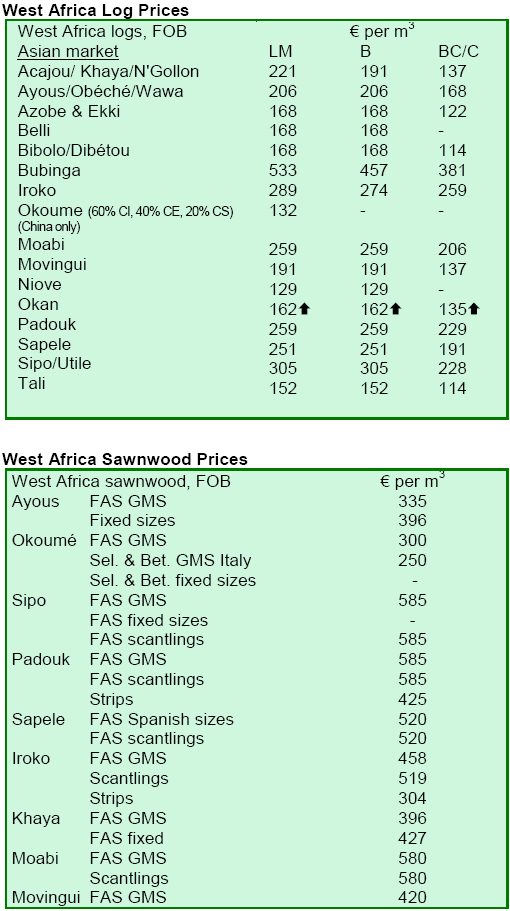
2. GHANA
TIDD contract approval rises 25%
According to data from the Contract Section of the Timber
Industry Development Division (TIDD) of the Forestry
Commission of Ghana, a total contract volume of
196,201m³ was processed and approved during the second
quarter of 2008. This represented a 25% increase over
first quarter figures for 2008. Furniture parts processed
and approved during the second quarter dropped by 78.2%
to 11,948 pieces when compared to the first quarter.
The contract volumes for plywood, poles, billets and logs
increased sharply in the second quarter. Plywood rose
41.1% while poles/billets/logs jumped by 104.7% when
compared to the first quarter. Plywood contributed 34.1%
of the total contract volume during the period under
review, regaining its position as the highest contributor to
total approved contract volumes.
With the exception of lumber and furniture parts, which
dropped in volume 22.3% and 78.2% respectively when
compared to the first quarter, contract volumes rose for all
major exportable products. Compared to the previous
quarter*s figures, contracts for sliced veneer, rotary
veneer, finger-jointed and dowels increased 47.4%, 36.9%,
82.8% and 77.8%, respectively, representing volumes of
13,636m3; 6,565m3; 5,532m3 and 192m3.
Ghana*s market performance improves in second quarter
Prices of Ghana*s timber and wood products, particularly
teak logs and poles to India, improved by an average of
USD30/m³ during the second quarter of 2008. The price
rise was USD10/m³ more than the average of USD20/m3
in the first quarter. Harvesting from private teak
plantations accounted for about 70% of the teak contracts
approved during the second quarter.
While buyers adjusted prices of lumber upward to
compensate for the fall in the value of the US dollar vis-角vis
the euro, it was difficult to achieve the minimum
Guiding Selling Prices (GSP) for plywood and rotary
veneer, which form the bulk of exports to the American
markets. Prices of ceiba rotary veneer were down an
average of USD27/m³ when compared to the GSP of
USD382/m3.
TIDD Pricing Committee removed the 5% price rebate on
wood products to the US market, which had an impact on
prices of plywood and rotary veneer. It is anticipated that
buyers would gradually respond by adjusting prices
upward to achieve the GSP during the third quarter.
A new rotary veneer processing line has been installed by
John Bitar and Company Limited to manufacture rotary
veneer with a thickness of 1mm and below. The first
contract for the product was submitted to TIDD for
approval during the second quarter, with prices of
EUR1000/m3 for sapele/mahogany/edinam and
EUR650/m3 for koto.
Prices of air-dried dahoma lumber to the Middle East, the
main destination for this product, showed signs of
improvement from the current asking price of USD350/m3.
Prices of some contracts submitted for approval during the
second quarter were between USD370/m3 and
USD400/m3.
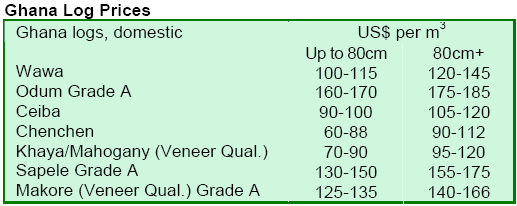
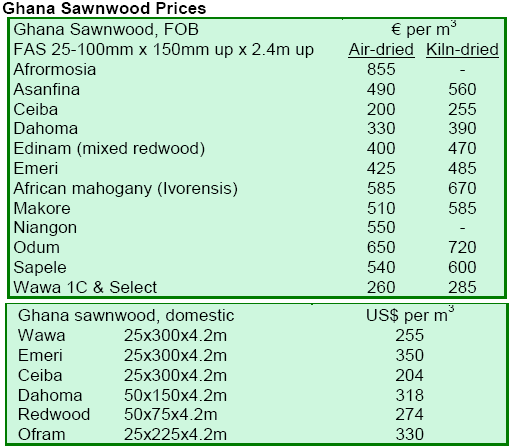
3.
MALAYSIA
FMU developments bode well for Sabah plans
Chief Minister Datuk Seri Musa Aman recently announced
positive developments on reforestation in Sabah, said The
Star. Musa had been present at the signing of an
agreement and memorandum of understanding between
Bornion Timber Sdn Bhd, China-based Guangdong
Guangken Rubber Group Company Limited, Universiti
Malaysia Sabah (UMS) and the Malaysian Rubber Board.
The agreement allows the establishment of a rubber tree
plantation in a Forest Management Unit (FMU) in Sabah.
Musa noted that the project would provide local job
opportunities and help achieve other plans within the
Sabah Development Corridor (SDC). The project, which
will cost RM230 million, will establish a plantation on
12,000 hectares of land, a rubber latex factory and a
rubber wood processing plant.
Malaysia set to sign VPA with EU
Bernama has reported that Malaysia is set to sign a
bilateral Voluntary Partnership Agreement (VPA) with the
EU. According to Mr. Cheah Kam Huan, the Malaysia
Timber Council*s (MTC) chief executive officer, the
signing of a VPA has the backing of various stakeholders,
including the timber industry. The VPA would require
Malaysia to ensure that illegally harvested timber is not
sent to the EU. The Agreement is also expected to give
Malaysia an edge in the EU market over countries that
have not signed VPAs. Cheah said Malaysia is expected to
sign the VPA with the EU by the end of this year or the
beginning of 2009.
Furniture makers expect strong sales despite global
economic slowdown
The Deputy Director of the Indonesian Association of
Furniture and Handicraft Industry (Asmindo), Basril
Djabar, suggested that recent international furniture and
handicraft exhibitions might be boosting sales of
Indonesian furniture. The Jakarta Post noted that
Indonesian furniture makers are expecting to generate
nearly USD2.4 billion this year, up from USD1.9 billion in
2007. Already, USD1.2 billion has been earned during the
first half of 2008, and Asmindo expects to generate the
remaining projected amount from new markets such as the
Middle East and Eastern Europe. A 26% increase in sales
is expected this year, despite the global economic
slowdown and soaring fuel prices. Asmindo expects to
continue to sell tables, chairs and filing cabinets from
rattan, wood and bamboo to traditional and new export
markets.
Prices drop as construction sectors weaken
Prices of Malaysian timber products declined as the
various construction and housing sectors in the US and
Europe continued to weaken. The strength of the US dollar
against other major currencies also led to the lowering of
Malaysian timber prices.
Timber businesses are optimistic that demand in Eastern
Europe and the Middle-East markets will help to cushion
the fall in prices. Prices of wooden furniture and plywood
are expected to see marginal declines. A cooling trend in
China*s real estate market is expected to spill into early
2009.
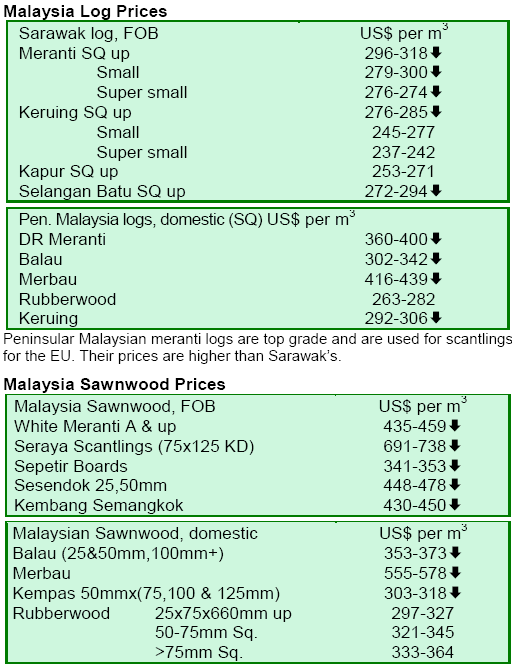
4.
INDONESIA
Anti-corruption drive improves Indonesia*s survey
rankings
The Australian said Indonesia*s rankings on Transparency
International*s (TI) corruption index had fallen from 143rd
last year to 126th in 2008. The Indonesia director for
Transparency International said that the rankings had
improved due to the Government*s efforts to handle and
eradicate corruption, including those actions taken by the
Corruption Eradication Commission. However, the
Indonesian TI office said that further actions, such as
seizing corrupt state officials, were necessary to reduce
corruption.
President Susilo Bambang Yudhoyono noted that efforts to
combat corruption would continue, according to Anatara
News. He indicated this might slow down government
performance or procurement of goods and services, but
that the efforts should not stop. He said particular efforts
were necessary to improve the justice sector.
Indonesian markets cautious despite strong timber
exports
Although the Indonesian economy*s growth is expected to
be 6.4% in the second half of the year, this target could be
threatened by a decline in commodity prices, said The
Jakarta Post. If commodity prices slide, it is likely to
reduce export revenue and could hurt capital markets. At
present, however, the balance sheets of Indonesia*s
commodity companies have remained strong.
Declining commodity prices and the depreciation of the
rupiah have not yet adversely affected the Indonesian
export market. Indonesian plywood exports have also been
surging as a result of increasing orders from overseas
buyers. This was particularly driven by the reconstruction
efforts after storms damaged parts of Taiwan and China.
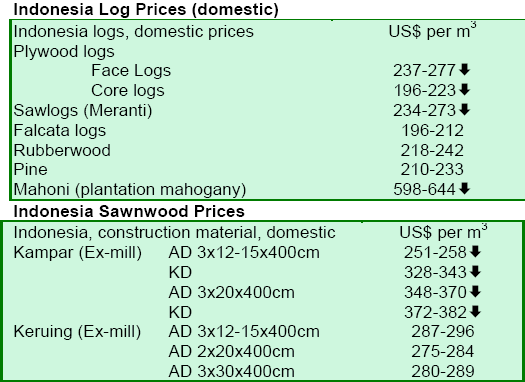
5.
MYANMAR
Teak exports continue steady
The market for teak seems to have neither improved nor
declined since May 2008. Nevertheless, in view of a new
price list that has been issued, tender average prices
climbed slightly. Moreover, experienced traders say the
effect of the world economic situation may soon have a
significant impact on teak trade. Indian buyers seem
noticeably silent this month, while Thailand*s buying of
lower grades of SG5 and SG6 was buoyant.
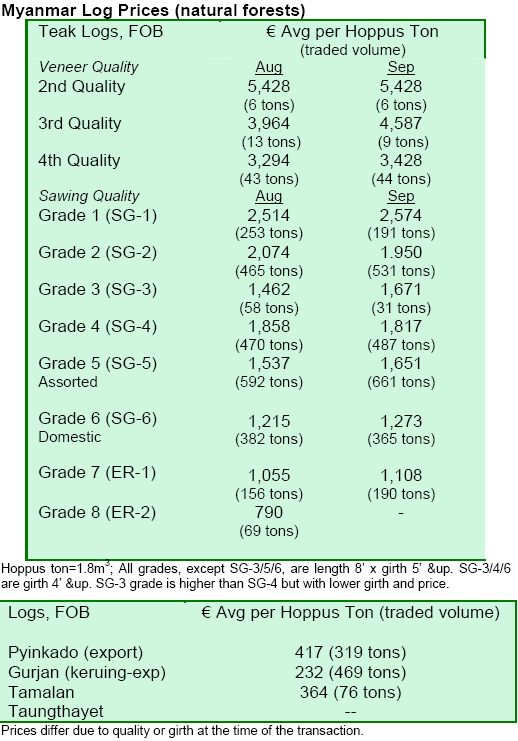
6.
BRAZIL
Regional workshop focuses on productivity of the
timber sector
Folha de Boa Vista noted that a regional workshop on
public policies for the timber and furniture sectors had
been held in the Northern Region of Brazil during the
second week of September. The purpose of the workshop
was to find ways to make productivity of the sector more
dynamic in the region. The workshop generated a
document to assist in establishing projects and strategies to
reduce bureaucratic public policies in the Amazon and
stimulate timber production activities in the region.
The workshop was promoted by the Brazilian Micro and
Small Enterprises Support Service (SEBRAE) and
targeted government officials, technicians, researchers and
entrepreneurs who contribute to establishing regulatory
frameworks for sustainable timber and furniture
production in the Amazon region. The workshop included
lectures about sustainability, access to technology,
innovation, governmental procurement under the General
Law on Micro and Small Enterprises and experiences
about the formulation of public policies for the timber and
furniture sector in Le Marche region of Italy.
Brazil steps up efforts to curb deforestation
According to Assessoria de Imprensa and Di芍rio de
Arax芍, some Brazilian state governments were
strengthening their environmental laws to combat
deforestation. The government of Minas Gerais will
submit a draft bill to the Legislative Assembly on the
quota for annual consumption of wood and by-products
from natural forests. If the bill were approved, Minas
Gerais would be the first Brazilian state to adopt
environmental legislation with fixed quotas on the use of
raw material originating from natural forests. The quotas
in Minas Gerais would range from 15% to 5%, declining
gradually by 2017, with the aim of reaching zero levels of
deforestation of native vegetation cover by 2023.
Currently, there is no legal restriction on the use of raw
forest material in Minas Gerais and industries can meet
100% of their raw material needs with resources obtained
from natural forests.
At the national level, the Brazilian Ministry of
Environment announced that at least five countries,
including Japan, Sweden, Germany, Korea and
Switzerland, in addition to Norway (see TTMR 13:17),
were interested in investing in the Amazon Fund. The
Fund, which was established by Decree No. 6527 in
August 2008, will be managed and monitored by the
National Bank for Economic and Social Development
(BNDES). BNDES expects to receive public and private
contributions at the domestic and international level to
invest in the prevention and monitoring of deforestation in
Brazil.
Exports drop 25.8% in August 2008
Brazil*s wood products exports (except pulp and paper)
dropped from USD394.4 million in August 2007 to
USD292.5 million in August 2008, a 25.8% decrease. The
charts below show the volume and value of exports for
August 2008 compared to the same month a year earlier:
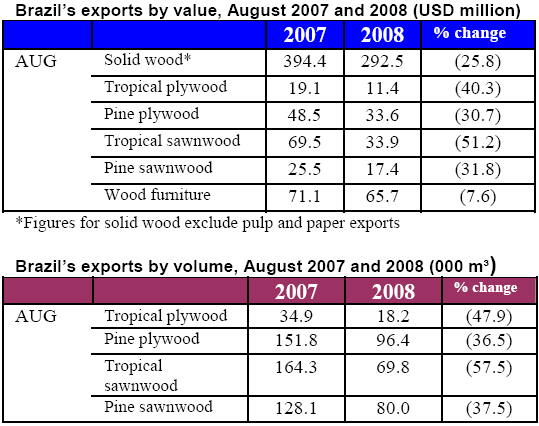
Changes in international timber market could be
opportunity for Brazil
According to Madiera Total, experts have speculated that
recent changes made to Russian timber export tariffs and a
future recovery of the US real estate market may be
opportunities for Brazil*s timber industry. Russia has
increased taxes on log exports, which will lead to soaring
costs for its raw log exports and has left open
opportunities for producer countries of finished products
such as plywood, doors and flooring. Since Brazil has the
capacity to increase exports of wood products and offers
certified products, the Brazilian Association of
Mechanically-Processed Timber Industry (ABIMCI)
believes this could be a good opportunity for the Brazilian
wood industry*s recovery.
Dubai continues to be seen as major furniture importer
Portal Moveleiro has reported on Dubai and the United
Arab Emirates* (UAE) potential to attract greater furniture
imports in the near future. Dubai has shown growth in its
furniture imports in recent years. The furniture market in
Dubai and the UAE in general is directly linked to an
upper class market and the real estate sector, both of which
are growing to a great extent. New buildings are being
built in Dubai every day and as a result, furniture
producers are planning to invest in the city.
According to the Brazilian Arab Chamber of Commerce,
growth of UAE furniture imports has been high in recent
years, at around 20%; thus, there is a possibility exports of
Brazilian furniture to the UAE will grow. According to the
Chamber of Commerce, the boom in the real estate sector
and the large number of immigrants to the UAE may boost
demand for Brazilian furniture.
In addition to Dubai, there are other Arab countries that
could be considered potential markets for Brazilian
furniture. The countries in the Gulf area, such as Saudi
Arabia, Qatar, Bahrain and Kuwait, are promising markets
and have great prospects for growth.
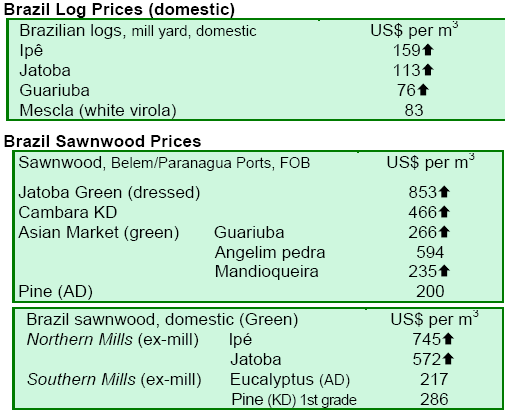
7.
PERU
Wood exports grow 10% in first half
According to statistics from the Export Association of
Peru (ADEX), wood exports from January through July
2008 grew 10%, with exports rising USD137 million from
USD123.52 million from the same period in 2007.
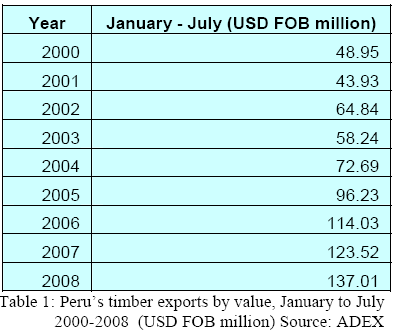
Exports in July 2008 were USD2.47 million less than
exports for the same month in 2007. The volume exported
to US and Mexico continued falling in July, in contrast to
the Chinese market, which showed gains in export
volumes during the same month.
The sectors showing significant growth for the January 每
July period were: building products (108.5%); veneers and
plywood (36.3%); semi-manufactured products (27.8%).
Among the products showing weakening export value
were furniture and parts (-18.4%) and sawnwood (-1.6%).
Sawnwood was the largest export item, representing
46.5% of sector exports. Exports from January 每July 2008
were USD63.66 million, while for the same period in 2007
exports were USD64.69 million. The main markets for this
sub-sector were Mexico, United States, China which
received 52.2%, 25.4%, 10.6% of sawnwood exports,
respectively.
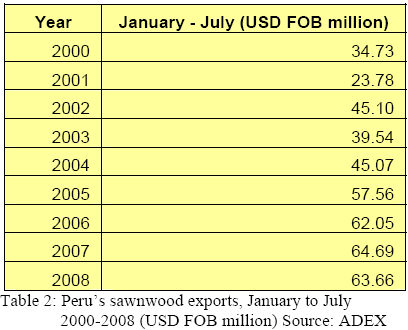
Semi-manufactured products represented 29.2% of wood
sector exports. Exports in January 每 July 2008 were valued
at USD 40.01 million, while exports for the same period in
2007 were valued at USD31.29 million, a 27.8% rise in
exports against 2007. Exports of semi-manufactured
products in July 2008 increased by USD1.13 million from
July 2007 levels. These gains were due largely to the
progressive growth of exports such as decking, for which
China has been the main destination market (70.8% of
exports).
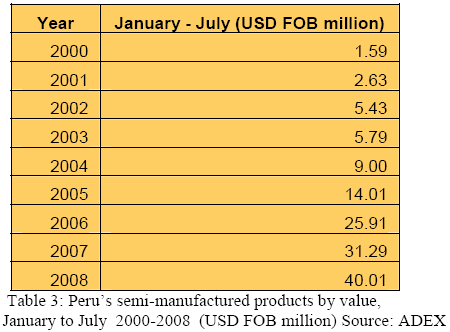
Veneer and plywood exports for the January每June 2008
period were USD17.62 million, a 36.31% jump from the
same period in 2007. Exports from the sub-sector show
Mexico as the main market for Peru*s exports (89.97%)
followed by Venezuela (6.69%).
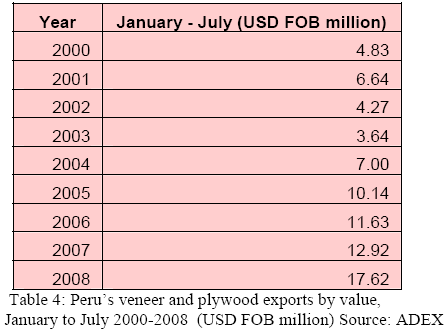
Furniture exports were worth a value of USD8.2 million
during the period, a 18.4% decrease from the same period
in 2007. The main market destination for these products
was the US (58.6%), followed by Italy (23.4%). Furniture
exports have substantially diminished in the current period
largely due to the recession in the US, the main destination
for Peru*s furniture.
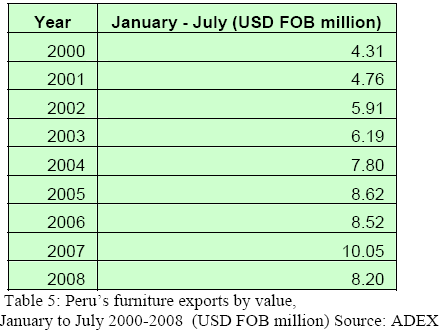
During the January每June 2008 period, exports were
concentrated in three markets representing 85.5% of total
wood products exports. Mexico represented 37.9% of
exports in the sector, growing 40.8% when compared to
the previous year, followed by China (25.6%), which has
grown 43.0% over the same period. The US was the third
destination market, representing 22.0%, although its total
exports fell 30.6% from first half of 2007.
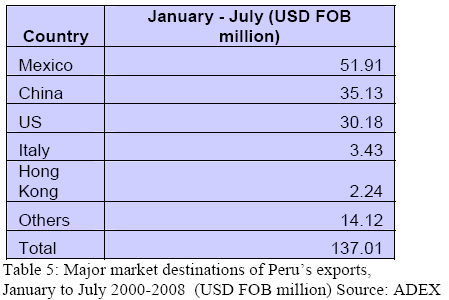
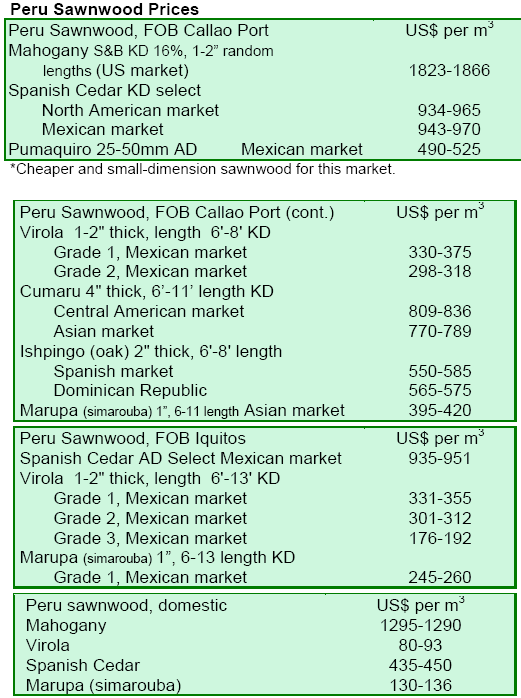
8. BOLIVIA
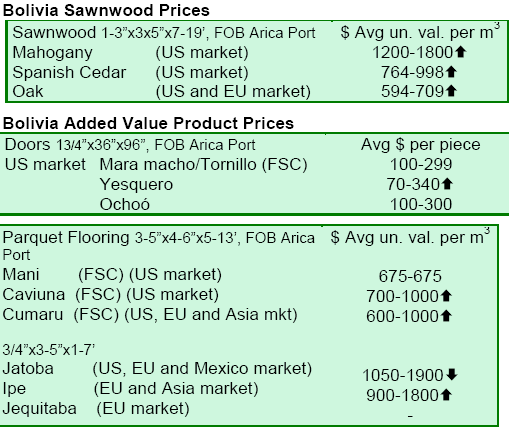
9. MEXICO
CONAFOR aims to increase production to 10 million
m3
The Director General of the National Forest Agency
(CONAFOR) announced that one of the main goals of the
presidential term is to increase timber production to 10
million m³. Over the last seven years, production has been
reduced to 6.6 million m³ which only supplies one third of
domestic consumption timber and the 1.6% GDP.
Consequently, two thirds of wood products consumption
requirements must be imported, which in 2006 resulted in
a trade deficit of 5.165 million pesos.
Another objective of the present presidential
administration is to incorporate 7.92 million ha of forest in
SFM activities. At the moment, the federal government
restores and conserves its forest through the ProTree
programme.
10.
GUYANA
Sawnwood exports continue to climb
For the period 1 - 15 September 2008, sawnwood exports
continued to climb and grew 32% when compared to the
previous fortnight. The major destination continued to be
the Netherlands, accounting for 23% of sawnwood
exported over the period. Other destinations include
Barbados, St. Lucia, Trinidad, St. Vincent, the UK, and
the US.
However, log exports for 2008 up to the end of August
2008, were lower by both volume and value than the
corresponding period in 2007. Other timber products
including sawnwood, roundwood and splitwood have
increased overall and have taken up most of the fall in
revenue created by the decline in log exports.
The export of roundwood piles has increased by 42% over
the previous fortnight. These are mainly greenheart piles
with some export of black kakaralli piles, one of the lesser
used species (LUS) being promoted by the GFC with
support from ITTO. The major destination for Guyana*s
roundwood piles for the period was Venezuela (43%)
followed by the US (24%), the Netherlands and Bahamas.
A number of LUS species were exported for the period
under review. Burada is currently being used for the
production and export of prefabricated housing and has
been exported to Caribbean markets. Additionally, it is
being processed and exported as timber and building
components to the Netherlands. Other species such as
darina, itikiboroballi, iteballi and suya have been exported
to destinations such as India, the Netherlands and
Trinidad, largely targeted for structural applications.
National consultation held to discuss policies on
Amerindian Community Forestry Enterprises
On 22 September 2008, the Government of Guyana hosted
a national consultation with over 60 indigenous
community members from 33 community groups across
the ten administrative regions of Guyana. This workshop
coincided with Guyana*s Amerindian Heritage Month
observed in September of each year. The participants met
to discuss and share experience on approaches that have
been successful in community forestry and identify future
needs to support livelihoods in these communities. Forests
are one of the main resources available to many
communities and to a significant extent supports income
generation, employment and welfare of Amerindian
groups.
One of the main objectives of the consultation was to
inform various workers in the forestry sector about the
government*s policies on indigenous groups and to gather
feedback from the different regions on how the policies
can better serve the interest of communities.
The feature address at the session was delivered by the
Minister of Agriculture with responsibility for Forestry,
Hon. Robert Persaud, who emphasized that Amerindian
communities play a very important part in maintaining
sustainable forest management at the forest management
unit and community levels. The Minister noted that
Guyana*s national log tracking system is largely
monitored by Amerindian communities, thereby enabling
the verification of the legality of origin of forest products
at a national level. He further expressed that the
Government of Guyana is of the firm view that sustainable
development of indigenous forest communities in Guyana
is best done using participatory forest management and
community development approaches.
Among the challenges identified by the communities were
the high cost of transporting forest produce to markets and
lack of required capital resources to engage in desired
added value forestry activities. The participants concluded
that working management structures can prove vital in
addressing some of their concerns at the community level.

|